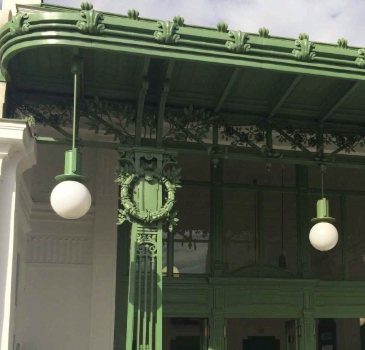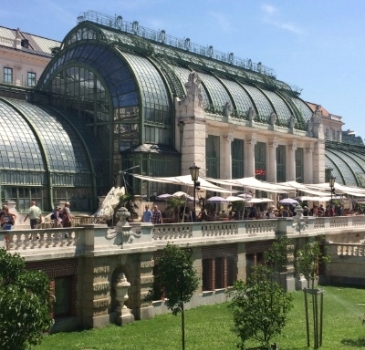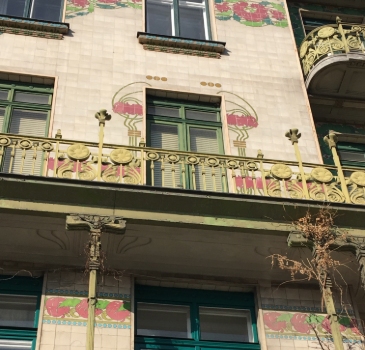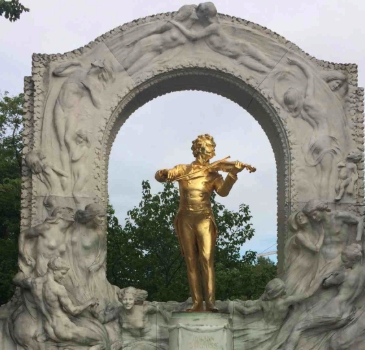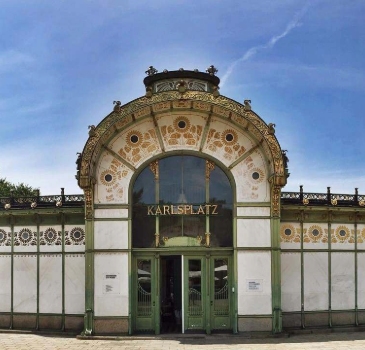Itinerary
On this 2.5-hour walking and public transport tour your guide will show andn explain you the main masterpieces created by Gustav Klimt in Vienna and at the same time will help you to understand his works and his role as co-founder of the Secession movement in Vienna.
Your guide will meet in front of The Secession Building, the icon of the Viennese Secession style. Originally conceived as an exhibition hall for the association in 1897, it remains to this day one of the best-known buildings in the Austrian capital.
Inside, you will discover The Beethoven Frieze, an impressive interpretation of Beethoven’s 9th Symphony created by Klimt in 1902 for an exhibition of the Secession movement. It represents an illustration of the human desire for happiness in a suffering and tempestuous world in which one contends not only with external evil forces but also with internal weaknesses. Today the Beethoven Frieze is considered one of Klimt’s key works and a highlight of Viennese Art Nouveau.
Written above the entrance to the building you can read the motto of the Secession association: “To each time its art. To art its freedom“. Your guide will explain you the context of the Vienna in 1900 as Klimt was the first president of the Secession, the artist’s association that decided to withdraw from the Association of Austrian Artists.
After visiting the Secession building and museum we will head to Belvedere museum. At The Upper Palace, you will see and learn about Gustav Klimt’s legendary oil painting “The Kiss”. Like much of Klimt’s work, this painting is undeniably erotic, but it is also profoundly tender. Inspired by Japanese mosaics and the universal appeal of romantic love, the painting uses the artist’s signature gold leaf to dizzying effect. With twenty-four works, the Belvedere holds the world’s largest collection of oil paintings by Gustav Klimt (1862–1918).
There are several links between this iconic artist and the Belvedere in Vienna, which houses the world’s greatest collection of Austrian art. Our specialised tour guide will explain to you some of them, for example major works by Schiele and Kokoschka.
During this private tour you will discover two of the most impressive highlights of Viennese Art Nouveau, also called Jugendstil or Secession. It will be a journey back in time to Vienna’s 1900 with a focus on the museums where you can appreciate the best of Klimt, a name has always been associated with gold paintings.
This private tour includes lots of references to history, architecture, decorative, cultural art, literature and music of the fin de siècle.
Tailored to your interests
Where the private tour Begins and Ends
Starting point will be the Secession building near Karlsplatz or in your hotel (if located nearby). We will end the tour in Belvedere Gardens – your private guide will recommend you a nice place to have a coffee and cake nearby.
Exclusions
The two following museum tickets:
Payment for public transport from Secession building area to Belvedere. As it takes only 25 minutes to walk from one place to the other, you can choose public transport or by walk.
Food and drinks.
Additional Information
Gustav Klimt & the Secession Style
Vienna is undeniably the city of Klimt par excellence, and an enchanting city steeped in history and artistic brilliance. In the Austrian capital, the echoes of this Viennese Art Nouveau genius reverberate through its grand museums and historic buildings, inviting art enthusiasts to embark on a captivating journey through his iconic works.
Vienna is a city filled with museums and hidden gems that offer glimpses into Klimt’s life and work. Art lovers can explore the artist’s former residences, stroll through the streets where he once walked, and immerse themselves in the atmosphere that inspired his creativity.
Gustav Klimt is an integral part of Vienna’s cultural identity, his iconic works symbolizing the city’s artistic and intellectual vibrancy. His paintings, characterized by their bold colors, intricate patterns, and sensual imagery, have captivated audiences for generations. Klimt’s association with the Viennese Secession movement, a groundbreaking artistic and architectural movement, further solidified his position as a leading figure in the city’s artistic landscape. His works, such as “The Kiss” and “Adele Bloch-Bauer I”, are not only celebrated for their aesthetic beauty but also for their exploration of themes such as love, desire, and mortality.
Beyond his artistic contributions, Klimt’s legacy has had a profound impact on Vienna’s tourism industry. Art enthusiasts from around the world flock to the city to admire his masterpieces, contributing to the local economy and enhancing Vienna’s reputation as a cultural destination. Klimt’s works have also inspired countless exhibitions, books, and films, further solidifying his place in popular culture. His enduring influence on art, design, and fashion continues to shape the city’s artistic landscape, making him an indispensable figure in Vienna’s cultural heritage.
Whether you’re a seasoned art connoisseur or simply curious about the world of art, Vienna offers an unforgettable experience. By following in the footsteps of Gustav Klimt, you can unlock the secrets of his artistic genius and gain a deeper understanding of the cultural heritage of this magnificent city.

